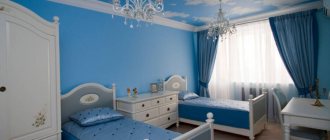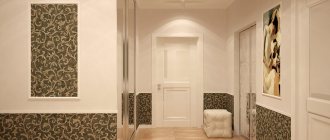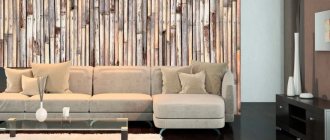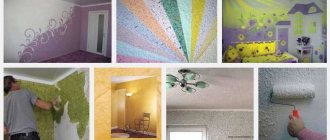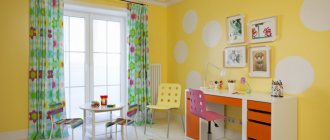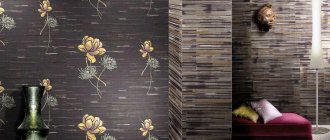MesterulManole
29236 0 18
MesterulManole October 30, 2016Specialization: many years of experience in finishing works of residential and office premises, summer houses, country cottages, etc. Hobby: cycling in all its forms
Choosing wallpaper for a small room is a problem for many
One of the most challenging design issues I've ever faced is how to choose wallpaper for a small room. And if at first I did some things at random, over time I gained experience. Today I can safely share my many years of experience with you.
A large pattern in light colors makes the bedroom elegant
White expands, a large print steals space, and textured wallpaper is completely unacceptable - forget about these stereotypes. Here are some really practical tips that will tell you how to choose the right wallpaper for a small room and that will add square footage to your room due to its visual effect .
Wallpaper color that visually expands the room
In modern apartments, the rooms are not large. You can expand the space only visually, using original design techniques:
- a universal method is to select light-colored wall finishes;
- skillful combination of shades and textures.
It is not advisable to use dark colors (burgundy, dark brown, black or deep purple). It is also worth remembering that large patterns and dense small prints visually reduce the space. But such restrictions cannot be considered too categorical, since there are many interesting ways to transform any apartment with the help of colors and textures.
Selecting wallpaper by texture
When choosing wallpaper for a small room, it is worth considering such a thing as the texture of the finish. There are several options here:
- Smooth wallpaper. This option cannot be called the best for a small room, since in some cases the room will look too simple. But if you choose the right pattern and color, the negative effect can be avoided. Therefore, to prevent the room from becoming boring, you need to choose wallpaper with a dynamic print.
- Embossed wallpaper is the best way to turn a small room into a spacious room. Even the presence of a slight relief will create a play of shadows and a difference in volume. And the richer the relief, the more noticeable the visual effect will be.
- Glossy wallpaper. Shiny finishes give a small room just the right amount of volume. At the same time, glossy canvases are endowed with a special decorative effect. Here designers advise paying attention to silk-screened and metallized wallpaper.
Wallpaper with imitation brick or stonework is not suitable for a small room. Such decoration will only reduce the already small space.
Wallpaper with the right prints for a small room
Wallpaper with prints and patterns fits organically into modern interiors of any style. Of course, to create a general background, it is advisable to choose canvases with a light base. Nuances of selecting materials:
- typical for designs in country and Provence styles;
- geometric prints (squares, rhombuses, circles) will add dynamics to the interior and make high-tech, minimalist furnishings laconic and effective. Abstract shapes painted in contrasting colors fit original into modern and retro designs;
- fashion trend - materials that imitate the texture and texture of rough surfaces (brickwork, cement, concrete). Such wallpaper for a small room, which visually enlarges the space, can be called accent wallpaper. They will emphasize the naturalness of the setting in the loft, Provence style;
- We can't help but mention the striped pattern. Hanging such wallpaper is a universal way to enliven a space and visually change the geometry of the room.
Is it possible to glue wallpaper with a geometric print and a floral pattern at the same time in a small room? It may seem that such a combination is unrealistic, but designers suggest experimenting and selecting materials of the same color palette.
Design options for a long narrow room
Long, narrow rooms can be made to look larger by using the right color and pattern on the walls. Geometry, especially with clear graphic contours, can create a feeling of freedom and permeability in a small room. Light walls with a glossy surface add light and space.
In the photo, the wall at the head of the bed is covered with wide striped wallpaper. This design technique allowed us to visually expand the narrow space of a small room.
In the photo you can see an interesting solution for expanding a narrow small room for a child. A long boring wall of a small room is decorated with expressive 3D wallpaper with imitation shelves with books in cheerful colors.
In the photo in a narrow arch, bright inserts in certain places serve both as a visual accent and to expand the long narrow passage. The use of expressive, sunny wallpaper adds light and joy to a small room.
Wallpaper for low ceilings
In order to visually raise the height of ceilings, there are some design techniques. Wallpaper with vertical stripes and a dark wide cornice between the wall and the white ceiling will help achieve the desired effect
The photo shows a small bedroom with a low ceiling. The stripes on the walls evened out the proportions of the room and added lightness and comfort to it.
The photo shows an example of using wallpaper in a small room with a low ceiling. The white walls were highlighted with maps filled with colorful wallpaper. The vertical arrangement of the cards added height and originality to the room.
Living room
A lot of time is usually spent on decorating a living room. The interior should please the owners and make a pleasant impression on the guests. Most often, wallpaper is used to decorate walls, because with it you can do repairs yourself, without the help of specialists. It is only important to choose the appropriate shade and pattern of the paintings in order to organically emphasize the style of the home. A win-win option for visually enlarging a room is light wallpaper. How to visually expand a room to avoid mistakes:
- the original decoration of the room with dark inserts will enliven the interior and help visually change the geometry of the room (move the walls away or move apart);
- it is preferable to stick light wallpaper with small patterns, because a large pattern will simply “eat up” the space of a compact room;
- striped canvases can visually correct the size of a room with a bay window: vertical ones will “raise” a wide wall, and horizontal ones will “expand” a narrow one;
- A well-lit room during the day is decorated with wallpaper in pastel cool shades (pearl, ash pink, lavender).
Naturally, we must not forget about design. Decorating one wall with a bright print or color looks organically in loft, minimalism, and hi-tech interiors. A small floral print, stripe, and check will highlight the coziness of country and Provence. Wallpaper with golden embossing looks aristocratic in classic-style living rooms.
Design principles for small rooms
Wallpaper used in a living space, which will be constantly visited not only by your loved ones, but also by guests, must be of the highest quality and wear-resistant.
Of course, you can neglect some characteristics that are mandatory for rooms with more difficult conditions (for example, resistance to moisture), but even in this room there are risks of accidental damage to the appearance of the wallpaper.
Replacing one canvas with a similar one is not so easy: most likely, you will have to change the entire finish, so we advise you to play it safe and immediately invest in better material.
To ensure that your living room design remains bright and updated for a long time, choose wallpaper that can withstand mechanical damage. It is desirable that the outer layer of the material does not wear out, and that random scratches do not stand out against the background of the overall pattern.
Tip: Wallpaper with a relief texture, as well as materials with small prints in rich colors, help hide damage on the walls.
Wallpaper should not fade under the influence of the sun : in a small living room, almost all the walls will be located close to the window, and constant contact with the rays will affect the durability of the shades.
Take care of your health: choose wallpaper that promotes air circulation and does not attract dust.
If you plan to gather guests in this particular room, select a suitable area in advance and decorate it with stain-resistant wallpaper. It is advisable to choose wallpaper with a washable coating that can be easily cleaned even from stubborn stains.
Taking into account all the characteristics necessary to preserve the appearance of the walls, the best options for decorating a small living room will be vinyl, silk-screen printing, non-woven and textile materials. Textiles require more careful care, but thanks to their pleasant design they will create a cozy atmosphere in the living room interior, conducive to relaxation.
Another feature that you need to pay attention to when choosing wallpaper for a small room is its effect on the perception of space.
The following finishing principles will help you make the room more spacious and comfortable:
- Wallpaper in light shades has the property of expanding the size of the room, so this color must be present. Light wallpaper can be combined with bright and dark inserts to enliven the interior and emphasize the desired style;
- dark and bright wallpapers are not used as a background in cramped rooms. But when glued to one of the walls or on two opposite surfaces, they will emphasize the desired effect: the walls will visually move away and free up space;
- large patterns on the walls will “eat up” the free space in the room. Replace such wallpaper with coverings with small images of calm shades;
- To correct imperfections in the shape or size of the interior, you can use wallpaper with stripes of different widths. A vertical line will raise the ceiling level, but can also reduce the area of the room, so use such wallpaper with caution . Wallpaper in a horizontal line is a universal option that allows you to correct the shortcomings of the room associated with the presence of small-width walls;
- if the room is well lit, you can choose wallpaper of a cold palette for the background. Such shades are especially popular in modern interiors: for example, gray and blue will fit perfectly into the calm design of the living room and set the mood for relaxation.
Please note that the design of wallpaper for the walls must match the style of the furniture and the purpose of the living room .
Some additional effects will help to emphasize the solemnity of this interior, as well as influence the feeling of space: shimmer, glitter patterns, glossy wallpaper surface, 3-D images.
Bedroom
Experts recommend choosing wallpaper in light pastel shades to decorate a small bedroom. If the option of white and beige canvases seems banal, then paste wallpaper in lilac, blue, and pistachio tones. Fashionable design ideas for decorating a bedroom:
- canvases of the same color, but similar shades are selected;
- one wall (most often behind the head of the bed) is decorated with patterned material;
- The ombre effect is a creative option for a room with a low ceiling. In this case, the tonality of the wall color changes from floor to ceiling (darker below, lighter above).
A fashion trend is the use of textured wallpaper. The surface of monochromatic “matting” coverings creates an interesting play of light and shadow. A spectacular option for wall decor is a combination of single-color textured and smooth wallpaper.
Little tricks
And a few more life hacks for your repair:
- Combining regular wallpaper and silk-screen printing of a related color will make the room visually larger.
- Avoid heavy and oppressive colors (dark blue, brown, purple, red). Well, if they are so dear to your heart, use them in the maximum dosage, use them only in detail.
- When choosing wallpaper, focus on the color of the furniture. Golden rule: ideal wallpaper is 2-3 shades lighter than the furniture.
- In a small room, both wallpaper with glitter and silk-screen printing feel great, the main thing is that there is not much of all this “splendor”.
- For dimly lit rooms, shades of white are used. And bright colors are used as spectacular accents.
- Photo wallpaper in a small room looks decent only on a perfectly flat wall. If in your case you cannot achieve this effect, opt for wallpaper with a pattern.
- Don't neglect textured wallpaper. Due to the appearance of a small shadow from the volume, the room visually appears larger.
- When combining different wallpapers, remember that their thickness should be the same. Otherwise, the joints will be very noticeable, and this will spoil the impression of the interior.
Contrasting combination of wallpaper on opposite walls of the room
Highlighting an accent wall in the bedroom with bright wallpaper
Combining different wallpapers to horizontally divide a wall
- Color combination is a science, the main rule of which is: “don’t overdo it.” Remember that you can combine no more than 3 colors and a maximum of 2 pattern options.
- If you like to use double wallpaper, then the top part should be lighter than the bottom, and the dividing border should not be placed exactly in the middle of the wall.
- And one more life hack for those who like to change their interior every six months: choose wallpaper for painting, only this will save your budget and give you the opportunity to make your dreams come true.
A popular solution for a room with a low ceiling is three walls with paintable wallpaper and one accent wall with striped wallpaper.
Wallpaper is a “powerful” finishing material. With their help, you can easily adjust the shape of the room, its dimensions and even the degree of illumination. And don't be afraid to experiment!
Children's
Most often, the design of a children's room is made bright, but it is not recommended to use more than three colors in the interior. Otherwise, the room will not look very good and will be annoying. When choosing a palette, you need to take into account the age of the children. It is known that children under 6-7 years of age are more receptive to bright colors. When decorating the rooms of schoolchildren and teenagers, it is recommended to give preference to a calm color palette.
The kids' room can be decorated with a light pinkish color. To prevent the interior from looking monotonous, popular fairy-tale characters or funny animals are depicted on the walls.
As children grow older, the interior palette can be changed, but you should not deviate from light pastel shades. Grayish, blurry blue tones are suitable for a boy’s room. Plain walls will be decorated with corresponding drawings (ships, planes, cars). Or one wall is covered with checkered or striped wallpaper. In the girls’ room, the ceilings are decorated in warm sand, beige, and lilac tones. The drawings are based on plant themes (flowers, trees, butterflies).
Kitchen
The owners, having chosen the finishing for the kitchen, strive not only to make the room more spacious. Wallpaper will help highlight the work area with the stove and the dining area, and will give the environment a beautiful look.
Canvases in warm colors (beige, peach) will bring coziness to rooms located on the north side. It should be borne in mind that the abundance of yellow, red or orange shades can visually reduce the space. The monotony of the situation will be corrected by bright elements. A fashionable technique is to decorate one wall or dining area with textured wallpaper or canvases with an ornament or pattern. Brown-yellow coverings with vertical stripes will make the ceiling visually higher.
Naturally, light walls will visually expand kitchens located on the south side. To “cool down” the atmosphere, preference should be given to a cold palette (pale cornflower blue, hyacinth). Bright contrasting turquoise wallpaper will bring a play of colors to the interior.
How to combine wallpaper for visual enhancement
A popular technique for visually increasing the area of a room is to combine different types of wallpaper. Thus, experienced designers use the following solutions:
- Contrasting combination of wallpaper on two opposite walls.
- Highlighting the accent using photographs or contrasting colors.
- A combination of different shades and patterns to separate the walls.
- Highlighting pale walls with a pattern with bright wallpaper.
To visually increase the free space in the room, it is recommended to combine two types of wallpaper in one interior. A combination of plain and colored coatings gives good results.
Modern wallpaper will help transform the design of a small room beyond recognition. In addition to the aesthetic role, they perform a practical function and create the impression of spaciousness and comfort. However, in order for the interior design to be correct and organic, it is necessary to carefully consider a lot of features and not deviate from the recommendations of experienced designers.
Hallway and corridor
To make a small hallway comfortable, you need to take into account the furniture, the color of the laminate and the ceiling. It is known that light colors will make the corridor more spacious, but you don’t have to limit yourself to a pale pastel palette. Dark and bright options can look appropriate and original. It is not recommended to select wallpaper with a large pattern or ornament.
Surfaces with small elements located vertically will visually raise the ceiling. But we must take into account that in this case the space will “narrow”. An original visual technique is to stick wallpaper with small, minimalistic patterns.
A fashionable trend is to decorate the corridor with textured canvases that imitate brickwork or a concrete surface. It is not advisable to cover the entire corridor with such coverings. The combination of textured and smooth wallpaper looks harmonious.
Features of a small room
Each small room has its own characteristics and has an individual layout. The following features cause difficulties during repair:
- Poor lighting. In some cases, there is no natural light at all, or the room is a walk-through room.
- Shape of the room. The easiest way to create a cozy layout is in a square room. And if the room is too elongated and looks more like a corridor, the task becomes more complicated.
- Some tiny rooms also have niches or projections.
- Door and window openings. Difficulties arise from both too large and very small doors and windows.
- Low ceilings. Even if the room is large, low ceilings visually make it uncomfortable and create a feeling of enclosure. And if there are not many square meters, then it’s a disaster.
All of the above nuances complicate the process of creating an interior design and make the room uncomfortable. Therefore, the main task of the designer is to use tricks and techniques that will make the ceiling appear higher, the room more spacious and brighter than it actually is. And wall decoration plays a leading role in this process. The main thing is not to be afraid of unusual bright solutions or non-standard colors.
Using wallpaper you can decorate the walls of a small room in an original way and visually expand the space
Wallpaper with small patterns unloads the interior and makes the walls less bulky
Form
The shape of the room is:
- square;
- elongated;
- rooms with sloping walls (attic);
- narrow, small, with low ceilings.
There is a simple rule on how to make a small room comfortable and cozy: the smaller the area of the room, the lighter the shade of wallpaper chosen. An abundance of color and pattern is detrimental for a tiny room; you will begin to feel tired in such a tacky space.
Light wallpaper in combination with furniture slightly darker than the walls helps to visually enlarge the space
The best solution for a square room is to create a bright accent on one wall. Therefore, paired wallpapers are often used - with a pattern and plain - complementing each other in color and texture. As an option: one wall is covered with wallpaper with a large geometric print or floral pattern, and the rest are decorated with plain wallpaper in a harmonizing color.
Bright wallpaper is perfect for decorating an accent wall in a bright room.
A combination of pink and blue wallpaper will add coziness and sophistication to the room.
The overall color concept maintains the harmony of the style. If you are not a supporter of plain wallpaper, then an option with vertical stripes of different widths would be a suitable solution for a square room. The combination of horizontal and vertical stripes looks impressive.
Wallpaper with a pronounced vertical pattern will visually raise the ceiling of the room
Illumination
In a small room, lighting plays a more important role in creating interior design than in a spacious room. Immediately decide on the features of your premises by answering the questions:
- Bright room or dark?
- What size is the window: large or small?
- Is there a loggia (or attic windows, if we are talking about such a room)?
The rule for choosing wallpaper depending on the degree of illumination sounds simple: the brighter the room, the cooler shades are chosen (white is also suitable). And if little light enters the room, then choose a warm wallpaper color (sand, cream).
To decorate a small bedroom, it is best to choose wallpaper with unobtrusive patterns.
Eye-pleasing colors promote relaxation and restful sleep
By wisely combining wallpaper in bright and pastel colors, it becomes possible to slightly “adjust” the lighting of the space, making the room cozy and comfortable. In addition, additional “lighting” appears due to wallpaper coated with mineral coating (for example, with quartz chips). Such finishing materials “respond” to any light source, and even with minimal lighting fill the room with a warm atmosphere.
Bathroom
When choosing coatings, it is important to remember that the walls in the bathroom are also decorated with tiles, stone, and plaster (especially in wet areas). It is desirable that all finishing materials be combined in color and texture.
In small bathrooms it is not recommended to use wallpaper in red, blue and black shades. When choosing a palette, the design style is taken into account. Canvases with small floral prints or narrow vertical stripes will fit into the interior of Provence. High-tech and minimalist bathrooms are covered with white textured wallpaper. Beige, sand, and golden shades will fit into the classic design.
Of course, when choosing wall paintings, you need to take into account the style of the room. But the popularity of blue and green shades is explained by the feelings of freshness and cleanliness that they bring to the environment.
Zoning using wallpaper
In order for the room to be closer to a square, you can not only try to “expand” the room, but also shorten a wall that is too long.
The living room often combines several areas, for example, a relaxation area and a study, or a dining area and a “sofa”. Zoning successfully supports the carpet on the floor, rug, podium. If so, then why not delimit zones in a narrow and long living room with the color of the walls?
Random contrasts are unacceptable, but if you take a closer look at the wallpaper collections, you can find stunning decorative models that fit together flawlessly.
Zoning a narrow room with wallpaper
Asymmetrical pasting is rarely successful - professional advice is very useful here. For inspiration, study wonderful design projects: the wallpaper for a narrow room in the photo contributes so much to creating the desired atmosphere in the work and guest areas that no questions arise about the appropriateness of such color zoning.
Symmetrical zoning with wallpaper
The symmetrical zoning with collectible wallpaper in the narrow room in the photo was done simply superbly. To maintain symmetry, one pattern/color is used in the center and edges of long walls, and another in between. As a result, two zones are clearly marked and each boasts pleasant proportions.
Photo wallpaper to expand space
Properly selected photo wallpapers can not only visually enlarge the room, but also bring a new look and mood to the environment. Designers recommend taking into account several subtleties of choice:
- the picture should blend organically into the interior;
- in rectangular rooms, photo wallpaper is glued to a long wall, otherwise the room may visually narrow;
- the image on the wallpaper should “fit” within the boundaries of the room;
- It is desirable that the background of the walls and the color palette are combined.
Naturally, the choice of photo wallpaper is also influenced by the purpose of the room. As a rule, hallways are rooms without windows (and therefore deprived of natural light). Light photo wallpapers will make them more spacious, you just need to choose the right pictures. Preference should be given to canvases with a vertical pattern (for example, a view from a window or the perspective of a narrow street).
In the bedroom, it is recommended to stick photo wallpaper behind the bed so that the image does not distract attention and does not interfere with restful rest. In a small room, canvases with medium-sized plant motifs look organic.
In the living room, it is quite possible to choose a contrasting background relative to the color palette of the photographic canvases. The fashionable theme of the drawings is urban or floral motifs. In order for the optical effect to appear, pictures with panoramic photos are pasted on a free wall that does not have any pieces of furniture (chairs, chests of drawers, cabinets, bedside tables).
In a children's room it is appropriate to stick pictures with fairy-tale characters or children's favorite characters.
What will make a room bigger?
Small-sized premises are characteristic of many Khrushchev-era apartments. And the conditions do not allow for a satisfactory redevelopment - the amount of space remains the same and it will not be possible to create an “extension”. How to visually enlarge a room? There are several simple ways to visually add “air” to a space. First of all, this is the use of curtains and mirrors.
A small room can be transformed by choosing the right curtains. To do this, you need to remember the main rules:
- choose light colors and thin, loose textiles;
- the canvases should be long, compressed in the form of an accordion, falling to the floor;
- the colors of the curtains must be combined with the wall covering; the use of contrasting and dark shades is unacceptable;
- there should be vertical stripes on textiles;
- Horizontal lines, large prints and designs should be avoided.
The most correct choice would be light, light and warm translucent curtains. They should be longer than the window and take up space on the floor, thereby creating the illusion of high ceilings.
Mirrors are the most popular and simplest technique, which you need to proceed with carefully. An excessive number of mirrors may not enlarge a small room, but, on the contrary, turn it into a matchbox.
For rectangular rooms, it is customary to place a mirror on one of the long sides. Thus, the space of the room is “trimmed” and it takes on the shape of a square. Typically, a similar problem of narrow space occurs in hallways and corridors.
In apartments, square meters are saved on bathrooms. Mirrors, glass and glossy surfaces will correct this defect. In the bathroom you should abandon frames and use mirror panels - this creates the effect of freedom. Tiles with a glossy finish are used for the walls, the shower is separated by a glass door, and the ceiling is made of mirrors.
Related article: Nuances of choosing a laminate to wallpaper color: successful combinations of shades
Wallpaper texture and shine
A light palette of shades is not the only way to visually expand the space of a room.
An original solution is to use textured wallpaper. The peculiarity of the canvases is that the uneven surface creates a play of shadows. Most often, wallpaper with a “matting” texture is pasted. Manufacturers offer many options for volumetric patterns. There is a particularly wide range of wallpapers that need to be painted.
Wallpaper with silk-screen printing stands out. Manufacturers offer products with a variety of patterns and designs. Thanks to the shiny surface, light is reflected, which additionally gives the room volume. Such embossed wallpaper is not very common and looks natural in classic interiors. The noble appearance of the paintings will decorate the bedroom, office, living room, kitchen (only for it you should select a material with a dense top layer so that you can periodically clean the surface).
Color or pattern
The color palette is the main thing that is taken into account when choosing wallpaper for a small room. A light palette visually enlarges the space (everyone knows this axiom, even people far from interior design).
Blue wallpaper refreshes the interior, adds air and space to the room
A golden pattern on the wallpaper will make the room brighter and sunny
The most successful “representatives” of the light palette: shades of yellow, gray-blue, pink-beige “duets” and white. In other words: by hanging light wallpaper in a small room, you will half solve the issue of limited space.
When choosing a color, take into account not only your own preferences and the level of illumination of a small room. You need to take into account the color and style of the furniture, the shade of the ceiling and floor.
If your small room is furnished with modern furniture in light colors, then the walls will easily “withstand” even rich, bright wallpaper. This is kind of one of the modern trends for creating a stylish and functional interior. And if there is a minimal set of furniture on modest square meters, feel free to use bright and even contrasting wallpaper. In this case, the room will not be tasteless and uncomfortable.
Fuchsia wallpaper in the interior of a modern teenager's bedroom
Bright orange wallpaper in a modern style bedroom
If you are the happy owner of antique interior items (table, armchairs, sofa), do not rush to buy wallpaper. Such furniture is very “capricious” and does not “get along” with all wallpaper. Even if you liked this or that option in the store, do not buy it right away. The best way to understand whether interior items will “accept” your choice is to take a sample in the store and attach it to the wall at home, next to the furniture. This way, you will definitely avoid the mistake of many.
The photo shows an example of choosing wallpaper for a small living room with antique furniture in Italian style
Blue wallpaper with silver ornaments in a retro-style office
A general rule also exists: wallpaper in a small room with antique furniture should be light and it is better if it is without a pattern.
The modern range of wallpaper is amazing: both in texture, and in quality, and in material - an amazing variety. Relatively recently, wallpaper with glitter appeared. Some argue that this option is only for large rooms. However, designers have proven that even in a tiny room such wallpaper will find its application. The main thing is not to cover all four walls with “gloss”. Decorate only one in this unusual way, and cover the others with plain, non-gloss wallpaper, “related” in color. A shiny surface looks best in a well-lit room, whether it is natural or artificial lighting.
Wallpaper with glitter is most in demand for interior design in modern style solutions
With the help of such wallpaper it is easy to focus on a certain part of the room.
Even a large pattern (flowers, geometry, abstraction) looks harmonious in a tiny room if only one wall is decorated with such wallpaper, and plain light wallpaper is chosen for the rest. And active elements - large drawings - will enliven the interior, make it unique in its kind, and even visually expand the space.
Paper wallpaper with a bright pattern in a children's room
Bright wallpaper with an expressive print in the interior of a small kitchen
Auxiliary decorative techniques for expanding space
Today, the trend is spacious, free interiors that are easy to create in houses or studio apartments. However, using design tricks, you can recreate any style in a small room.
Mirrors are a universal way to visually expand a room. Narrow mirror sheets from floor to ceiling are fixed in the corners of living rooms.
In the hallway, high mirrored decor is laid out in tiles.
Photo wallpapers that increase space
One of the design techniques for expanding space in small apartments and studio apartments is the use of photo wallpaper. When it is not possible to purchase a ready-made fresco or invite an artist to paint it, you can cover the view wall with photo wallpaper.
A perspective image of nature or a panorama of the city with plans of different sizes will create a certain mood in the room. In a studio apartment, proper zoning with photo wallpaper will help avoid clutter.
A glossy white ceiling will make the room appear taller and more spacious.
Small-sized furniture with a shade to match the walls seems to “dissolve” in the room. Products made of transparent plastic look unusual.
If you decorate one wall with wallpaper in an accent dark color, you will visually “deepen” the room. This is an ideal way to zone a room. In the kitchen you can visually highlight the dining area, and in the living room you can emphasize the boundaries of the work area.
You can visually raise the ceiling not only with stripes, but also with other vertical patterns (for example, rhombuses, zigzags). Also, wall decor located horizontally, below the traditional level (for example, narrow curtains near a balcony, window) can visually lengthen a room. A non-standard technique is the installation of low furniture (chests of drawers, wide bedside tables, sofas or armchairs).
The parameters of standard apartments (Khrushchev-era apartments) often leave much to be desired. However, with the help of certain design techniques, it is not difficult to make rooms visually more spacious. Moreover, this does not always require significant financial costs. The easiest way is to decorate the walls correctly by choosing the right color and texture of the wallpaper.
Basic Techniques
It is not necessary to cover all walls with the same wallpaper. For modern interiors, such a traditional method will be quite boring and dull. Designers have long come up with a number of techniques for combining surfaces of different textures and shades that are suitable for both large and small rooms. We will get acquainted with some layout options for two or more types of wallpaper further.
Reception of “Different Walls”
This method will require two types of wallpaper: plain and bright with a pattern or textured surface. The principle of combining is to cover opposite walls with the same wallpaper. You should be careful with rooms of non-standard configuration. Cold shades make the object move away, so blue, light blue, and green wallpapers are not recommended for finishing “short” walls, as the room will seem even narrower.
Reception separation
Space division can be done in two ways:
- Horizontal;
- Vertical.
In both cases, you have to sacrifice something: either the height of the ceiling or the width of the room. The first option is suitable for small rooms with high ceilings. It helps to cope with the so-called well effect. Horizontal separation is usually carried out at a height of 0.5-0.7 m from the floor. The strip can be “adjusted” to some large piece of furniture. For example, the back of a sofa, the head of a bed or a dining table. In rooms with windows, they are guided by the height of the window sills. The vertical division visually raises the ceiling. Usually two types of wallpaper are combined, which differ in color and texture. There are a lot of combination options: symmetrical, asymmetrical, narrow stripes with wide double or even triple ones. If you need to completely erase the boundary between it and the wall, one of the strips of wallpaper “extends” to the ceiling, making the angle between the surfaces inconspicuous.
Accenting
This method will require two types of wallpaper: simple, plain and bright, with an original pattern that attracts attention. The first to paste over three walls, and the second - the remaining fourth. It will become the accent, the main highlight of the interior. In the bedroom, attention is drawn to the wall against which the bed rests with the headboard. In the living room, this is the surface behind the back of a large sofa. In the kitchen, the role of an accent wall is played by the one that became the background for the dining group.
Alternation
Alternation is carried out using both two and three types of wallpaper. Unfortunately, the second option is not suitable for small rooms, since excessive diversity will not benefit them. You can combine different wallpapers: plain with floral or geometric patterns, striped or checkered with florists, abstract with different motifs. For small rooms, it is better to opt for single-color wallpaper, which will highlight the brightness of the floral pattern or the richness of wide stripes.
Reception diagonal
Covering one wall with wallpaper diagonally is an extraordinary and bold decision. The best option for such an experiment would be vertically striped wallpaper. An unusual wall will greatly distort the space and it will be perceived completely differently.




